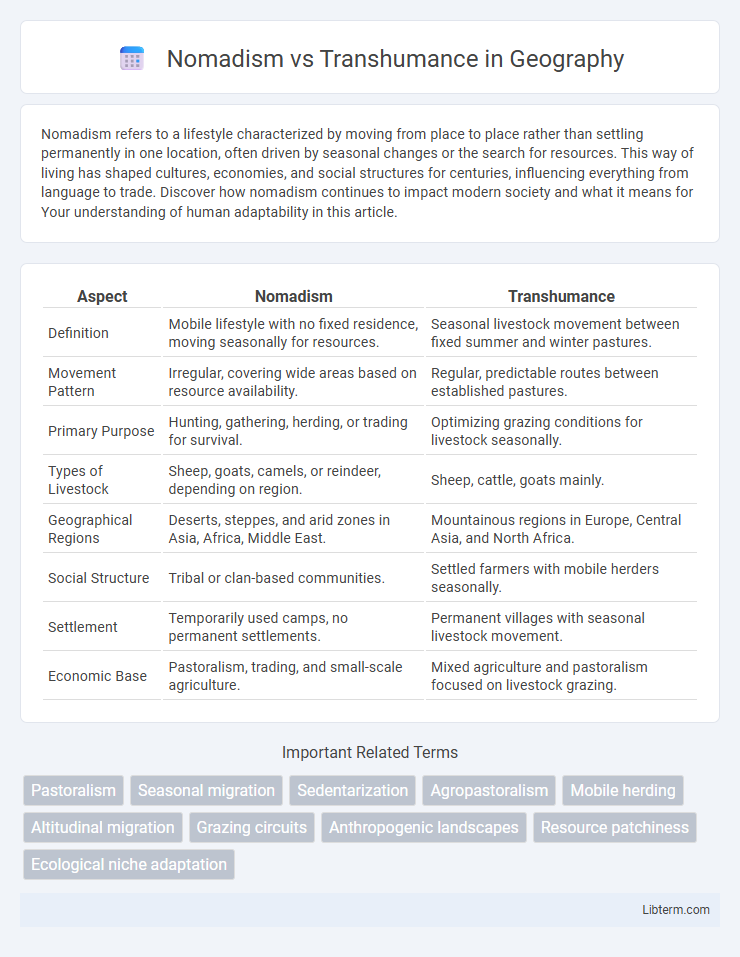Nomadism refers to a lifestyle characterized by moving from place to place rather than settling permanently in one location, often driven by seasonal changes or the search for resources. This way of living has shaped cultures, economies, and social structures for centuries, influencing everything from language to trade. Discover how nomadism continues to impact modern society and what it means for Your understanding of human adaptability in this article.
Table of Comparison
| Aspect | Nomadism | Transhumance |
|---|---|---|
| Definition | Mobile lifestyle with no fixed residence, moving seasonally for resources. | Seasonal livestock movement between fixed summer and winter pastures. |
| Movement Pattern | Irregular, covering wide areas based on resource availability. | Regular, predictable routes between established pastures. |
| Primary Purpose | Hunting, gathering, herding, or trading for survival. | Optimizing grazing conditions for livestock seasonally. |
| Types of Livestock | Sheep, goats, camels, or reindeer, depending on region. | Sheep, cattle, goats mainly. |
| Geographical Regions | Deserts, steppes, and arid zones in Asia, Africa, Middle East. | Mountainous regions in Europe, Central Asia, and North Africa. |
| Social Structure | Tribal or clan-based communities. | Settled farmers with mobile herders seasonally. |
| Settlement | Temporarily used camps, no permanent settlements. | Permanent villages with seasonal livestock movement. |
| Economic Base | Pastoralism, trading, and small-scale agriculture. | Mixed agriculture and pastoralism focused on livestock grazing. |
Defining Nomadism and Transhumance
Nomadism is a lifestyle characterized by continuous or seasonal movement of communities without permanent settlements, often motivated by hunting, gathering, or trading needs. Transhumance involves the seasonal movement of livestock between fixed summer and winter pastures, combining settled agriculture with migratory herding practices. While nomadism implies mobility as a primary subsistence strategy, transhumance reflects a cyclical pattern tied to ecological zones and agricultural cycles.
Historical Background of Nomadic and Transhumant Societies
Nomadic societies historically emerged as mobile groups primarily engaged in hunting, gathering, and pastoralism, adapting to diverse environments across Central Asia, the Middle East, and North Africa since prehistoric times. Transhumance developed as a specialized form of pastoralism involving the seasonal movement of livestock between fixed summer and winter pastures, prominent in Mediterranean Europe, the Alps, and parts of the Middle East since the Neolithic era. Both systems shaped social structures, economies, and cultural practices, influencing the development of early trade routes and territorial organization in their respective regions.
Geographic Distribution: Where Nomadism and Transhumance Thrive
Nomadism predominantly thrives in arid and semi-arid regions such as the Sahara Desert, Central Asia, and the Middle East, where communities move continuously to access scarce water and grazing land. Transhumance is chiefly found in mountainous areas like the Alps, the Andes, and the Himalayas, where pastoralists seasonally migrate livestock between lowland winter pastures and highland summer grazing areas. These distinct geographic distributions reflect adaptations to varying environmental conditions and resource availability.
Patterns of Movement: Nomadic vs Transhumant Lifestyles
Nomadism involves continuous or cyclical movement across vast areas with no fixed home, driven by the search for resources like water and pasture, often adapting to seasonal changes. Transhumance is a seasonal, structured migration pattern where herders move livestock between fixed summer and winter pastures, typically at different altitudes. Nomadic patterns are more fluid and less predictable, whereas transhumant movements follow established routes and schedules tied to environmental conditions.
Livelihood Strategies: Subsistence and Economic Activities
Nomadism involves continuous movement of communities seeking pasture and water for livestock, relying on herding as the primary subsistence and economic activity. Transhumance features seasonal migration between fixed summer and winter pastures, integrating crop cultivation with livestock rearing to diversify income sources. Both livelihood strategies optimize resource use in arid and semi-arid regions, balancing ecological constraints with economic needs.
Social Structure and Community Organization
Nomadism features fluid social structures with small, kin-based groups adapting to variable environments, often lacking permanent hierarchies. Transhumance relies on stable, often multi-generational communities with defined roles and collaborative decision-making tied to seasonal livestock migration patterns. Both systems emphasize communal resource management but differ in permanence and social complexity.
Environmental Adaptations and Sustainability
Nomadism involves continuous movement across vast landscapes to access dispersed resources, promoting minimal environmental impact through low-intensity land use and allowing ecosystems to regenerate. Transhumance centers on seasonal migration between fixed pastures at different altitudes, optimizing resource utilization while maintaining soil fertility and biodiversity in mountainous and grassland regions. Both practices exemplify sustainable environmental adaptations by aligning livestock grazing patterns with ecological cycles, reducing overgrazing, and preserving habitat resilience.
Cultural Practices and Traditions
Nomadism involves continuous movement without a fixed home, where communities adapt their cultural practices to diverse environments, emphasizing mobility, resourcefulness, and often oral traditions that reflect their migratory lifestyle. Transhumance centers on seasonal migration between fixed summer and winter pastures, fostering cultural traditions deeply tied to specific landscapes, including rituals, festivals, and agricultural knowledge passed through generations. Both lifestyles integrate unique social structures and ceremonies that sustain communal identity and ecological harmony within their specific modes of mobility.
Challenges in the Modern Era
Nomadism faces challenges such as land dispossession, climate change, and modern state policies restricting mobility and access to traditional grazing lands. Transhumance struggles with infrastructure development, agricultural expansion, and legal boundaries that disrupt seasonal migration routes. Both practices encounter pressures from urbanization and globalization, threatening cultural heritage and sustainable pastoral livelihoods.
The Future of Nomadism and Transhumance
The future of nomadism and transhumance hinges on adapting traditional practices to modern environmental challenges and socio-economic changes, emphasizing sustainable land management and climate resilience. Technological integration, such as GPS tracking and mobile apps, enhances herd monitoring and migration efficiency, while policy frameworks increasingly support indigenous rights and mobility corridors. Sustainable development goals drive innovation in preserving pastoral livelihoods, ensuring both systems contribute to biodiversity and carbon sequestration amidst global environmental shifts.
Nomadism Infographic

 libterm.com
libterm.com